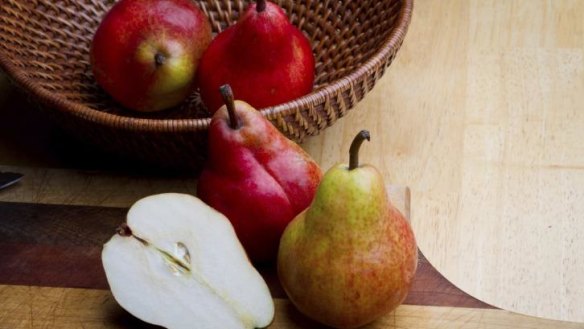How to grow red Australian pears in Canberra

As the cooler days of autumn arrive, we look forward to the tastes of autumn, and with taste comes colour. Bright-red colours speak to us of life and pleasure, so it is with the red pears that are ripening now.
Red Sensation is a wonderful early-season pear that has a lot of local, Australian history. Occasionally, a fruit grower will notice that one branch of a fruit tree is producing a new sport. It is not quite a new variety, but a mutation of the main variety growing on the rest of the tree. Sometimes the change can be just a variation in colour. Sometimes the fruit can be slightly different in character too.
In the early 1940s, in an orchard of the Mock family in Victoria, one of the green Williams pear trees sent forth a branch that produced fruit with a bright-red skin. It was the same shape and same flavour, but a little sweeter, with a higher sugar content than the original Williams pear, and the skin of the pear became brighter and brighter ruby red as it ripened.
This pear has become very popular and is well named Red Sensation. It took nearly 20 years for other pear-producing countries to discover it, being introduced into the United States only in 1959.
The Williams pear, known as the Bartlett in North America, dates back to before 1770, arising in Aldermaston, England. It was taken to the US in 1799, and promoted widely by Enoch Bartlett, of Massachusetts, which resulted in this local, northern name. However, despite being one of the most widely grown pears in the world, it has only recently thrown this red sport, and that in our Australian backyard.
Red Sensation is a high-quality, smooth-tasting, deliciously sweet pear. With its buttery, smooth flesh, it is excellent for eating fresh. Unpeeled, it can add a distinctive touch to a salad. It is an excellent dessert pear and very suitable for very young children.
The tree will produce quite heavy crops, five or six years after planting. This variety is not as vigorous as some other types of pear trees, so you can plant it in a smaller garden or espalier it along a boundary fence or brick wall to good effect.
Pear trees prefer full sunlight and lighter, well-drained soils. However, they can tolerate heavier soils, such as those found around Canberra, more so than most other fruit trees. They need 700 chill hours during winter to set a good crop. Red Sensation is a partially self-fertile pear, but will produce heavier crops if planted beside another pear tree that flowers at the same time. This can be a Beurre Bosc, Winter Nelis, Rouge d'Anjou or the Nijisseiki nashi pear.
There are few pear varieties with red skins. The two other notable ones mature later in the season, in April. They are also sports of original green-skinned varieties.
The Rouge d'Anjou is the red-skinned sport of the wonderful late-season pears from the Anjou (Angers) region of France. It has white, juicy, highly flavoured flesh beneath its deep-reddish-purple skin. The trees are regular heavy bearers, and it is my favourite.
The little Corella pear has a quite different history. Its antecedent is the Forelle pear from Germany. It was brought to South Australia by German migrants, and a brighter red sport arose in the orchards of the Barossa Valley. The bright colour of its skin suggested a likeness to the little corella bird, hence the name. It is a late-season pear of distinction and can be served fresh or in a salad. It ripens in mid to late April.
Red Sensation pear salad
3 Red Sensation pears
Juice of 1 lemon
1 handful baby cos lettuce
1 handful buttercrunch lettuce leaves
½ radicchio
50g rocket leaves
½ cup fresh basil tips
Vinaigrette
¼ cup lemon juice
2 tbs apple cider vinegar
1 tbsp extra virgin olive oil
1 tsp Dijon mustard
2 cloves garlic, crushed
pinch of sugar
salt and pepper to taste
Slice the pears in half, lengthways, remove the cores and then cut into five to six-millimetre-thick slices. Arrange in a pattern on a large serving plate and sprinkle with lemon juice. Tear the lettuce leaves and radicchio, rinse in water and pat dry, then place in a medium-sized bowl. Add the rocket leaves and basil tips.
Whisk together the lemon juice, cider vinegar, oil, mustard, garlic and sugar in a small bowl until well combined. Add a little salt and pepper to taste.
Arrange a portion of the salad leaves on a serving plate and lay the pear slices on top. Add the remaining leaves. Drizzle the vinaigrette across the salad just before serving.
This week in the garden
Plant a row of leeks, some European spinach and a last row of Asian greens.
Plant some seedlings of winter cabbages and keep on planting garden peas and snowpeas in beds that have finished cropping.
Should the weather forecast indicate any overnight temperature below 5C, drape some hessian or calico covers over any remaining crops of beans, zucchinis, capsicums and tomatoes.
Give all of your vegetables and strawberry plants an early-autumn dose of seaweed or fish emulsion spray to boost their late production and keep the plants healthy.
When digging up your potatoes, take care to dig deeply and remove even the small, chat potatoes to use in a specialty vegetable dish.
Owen Pidgeon runs the Loriendale Organic Orchard near Hall.